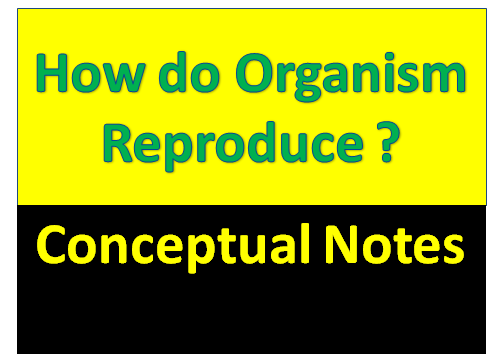
What is Reproduction
- The biological process in which organism produce new organism of their own kind .
- Reproduction is not an essential life process like Nutrition Respiration Transportation
Why reproduction is important
Necessary for continuation of species
Unicellular → Multicellular → Long time survive species
Do organism produce exact copies of their own in the reproduction ?
Reproduction
Cell → DNA
- DNA is replicated and its copies are made and in DNA copying additional cellular apparatus are also created
- There is a slight variation in the process of copying of DNA
- During reproduction DNA copies generated will be similar but may not be identical to the Original .
Why Variation is Important ?
- Variation is useful for the long term survival of any species
Types of Reproduction
- Asexual Reproduction
- Sexual Reproduction
Asexual Reproduction
- The mode of reproduction which involve a single parent is called asexual reproduction.
Features of asexual Reproduction
- It consumes less time and energy
- It involve less variation which does not lead to evolution
Sexual Reproduction
- It involves two parents
Types of Asexual Reproduction
- Fission
- Budding
- Spore formation
- Regeneration
- Fragmentation
- Vegetative propagation
Fission
- It can be defined as the splitting of a unicellular organism into two or more separate daughter cells
Types of Fission
- Binary fission
- Multiple fission
Binary Fission
- when a unicellular organism divide it’s body into two new bodies then such a fission is binary fission
- for example- Amoeba, Paramecium
Multiple Fission
- The process in which many daughter cells are produced from a parents cells instead of two daughter cell.
- For example Plasmodium,
Budding
- It is an asexual reproduction method in which an organism develops from a bud of an existing organisms.
- for example- Hydra
Spore Formation
- It is a form of sexual reproduction in which parent plant produce hundreds of tiny spores which can grow into new plants.
- For example fungi, rhizopus , bacteria
- spore formation in rhizopus large number of spores are produce in one sporangium which lead to production of more number of offspring
- spores are distributed easily by air to far of places to avoid competition at one place.
- spores are covered by thick walls to prevent them of unfavourable condition
Fragmentation
- It is a form of asexual reproduction in which an organism breaks down into several fragments it occur only in the case of multicellular organisms it does not occur in unicellular organisms
- For example – spirogyra
Regeneration
- It is a form of asexual reproduction where the organism is capable of regrowing certain parts of this body loses them
- for example plan aria, starfish
- Every part of the organism does not have the ability to regenerate the cells that have the ability to regenerate can regenerate again
Vegetative Propagation
- It is the process of formation of a new plants from detached vegetative part such as root stem and leaves
Natural vegetative propagation
- Vegetative propagation from root →sweet potato
- Vegetative propagation from stem→ Potato
- vegetative propagation from leaves → Bryophyllum
Artificial vegetative propagation
- In this we have to put some efforts from our side
- It is done by three methods by cutting grafting and layering
- vegetative propagation from cutting →Rose
- vegetative propagation from grafting → mango, Rose
- vegetative propagation from layering→Jasmine lemon etc
Sexual Reproduction
- It can be define as the production of new organism by the combination of genetic information of two individual of different sexes
- Male → Female →New form
Importance of sexual Reproduction
- The variation that occurs is very important for the long term survival of any species
- Two parents are involved in sexual reproduction
- Due to this the variation will be very high
- Because of that species will survive for a long time
- Due to that evolution will also be more
- Since sexual reproduction produce more variations as compared to asexual reproduction which lead to more evolution and variation
Difficulties in sexual reproduction
- DNA Double →Specialised cells →Germ cells, sex cells, Gametes, Reproductive cells
- Female germ cell is slightly bigger in size and it stores the food
- Male germ cell are motile and their size is very small
Fertilisation
- The process in which male gamete and female gamete fuse together to form a cell called zygote is called fertilisation
Sexual reproduction in flowering plant
| Uni sexual Flower | Bisexual flower |
| There is only one reproductive part in any flower stamen or pistil so we call such a flower uni sexual flower
For example Papaya and watermelon |
In a flower have both the reproductive parts stamen and pistil so we call such a flower as a sexual flower |

Male reproductive part
- Stamen is the male reproductive part
- Which releases pollen grains which are yellowish in colour Anther and filament
Female reproductive part
- The pistil is the female reproductive part of the flower which present in the center of the flower
- Stigma, Style, Ovary
- The transfer of pollen grains from another to the stigma a flower is called pollination
- Self pollination
- Cross pollination
- Self pollination can be seen only in bisexual flowers
- cross pollination can be seen in both bisexual flower uni sexual flower
Does the pollen grains automatically reach the stigma ?
- Pollen grains are transferred through some agent
- For example wind water and animals
Sepal
- It protects the flower in its initial stage
Petal
- The provides attraction to the flower which attracts small animals and insects like butterfly etc
Double fertilisation
- The process of fusion of one male gamete which the egg along with the union of second male gamete with the two polar nuclei or the second nucleus is called double fertilisation
Reproduction in human beings
So as we grow old some changes start happening in our body
|
1 Category |
2 Category |
| · In the early age our height grows very well
· Our milk teeth fall out and new teeth come in |
· Reproductive changes
· The age of a teenager is 12 to 13 years |
Similar change in boys and girls
- Growing of thick hair on the new parts of body such as armpits and the genital area between the thighs.
- Thinner hair can also appear on legs and arms as well as on face
- The skin frequently become oily and we might begin to develop pimples
- we begin to be conscious and aware of both our bodies and those of other in new ways
Different different change in girls and boys
- Size of breast begin to increase
- Darkening of the skin of the nipples at the tip of breast
- Girl begin to menstruate around this time
Boys
- Thick hair growth on face
- Voice begin to crack and become heavy
- Size of penis begin to increase and become enlarge and individual become capable of reproduction
All the changes take places slowly
- Thick hair growth on face
- Size of penis begin to increase and become enlarge
Girls
- Sizes of breast begin to increase
These do not happened in all at same time
- It is not compulsory that these changes occurs simultaneously in both
- An individual may be re productively mature earlier and some may be later
- So this changes can vary from Individual to Individual
All these changes are aspects of the sexual maturation of the body
- In early age our body grows very quickly
- In teenage years our reproductive cells become active and this condition is called puberty
- The time in life when a boy or girl become sexually mature is called puberty
- 10-14 years for girls
- 12-16 years for boys
External release of germ cell from the bodies of Individual
internal transfer of germ cell
- Both the individual join each other’s body due to which internal transfer of germ cells takes place
- And the internal transfer is possible only through the process of mating
What is mating
- It is pairing of opposite sex individual for the purpose of reproduction
- As in male individual penis should be healthy and should be erect
- it is also very important to mature the reproductive organ and breast of the female
Male Reproductive System
Testis
- Testis are primary reproductive organs found in males which are found in pair
- They are found outside the abdominal cavity
Function of testis
- These are responsible for the production of sperm
- They secrets testosterone which regulate the formation of sperm and also responsible for the changes in appearance at the time of puberty
- They start producing sperm when the body hits puberty
Scrotum
- The testes lie in a brown sac called the scrotum and are located outside the abdominal cavity
- The testes and scrotum are located outside the abdominal cavity because sperm production requires a lower temperature than our body temperature
Vas deferens
- The sperms produced in testes are carried through vas defrence to the Urethra
- It is a long duct so it is called sperm duct or duct deference
Urethra
- Is this common passage for urine and sperm
Prostate gland (seminal vesicle )
- It secrete Milky fluid that increase to the mobility of the sperm
- And it also provides nutrition to the sperm
- when sperm gets mixed in this milky fluid we call that mixture as semen.
How does sperm look like ?
- The sperms and urine can not discharge together
What happens in the process of reproduction
- when mating occur vagina receives sperm cells
Placenta
- It is the connection between embryo and mother side
- It transports oxygen and glucose towards developing foetus through blood
- It releases carbon dioxide and urea as waste product
- Gas station period is of 9 months
What happens when egg is not fertilised
- When eggs does not get fertilised it survive for 1 to 2 days
- This happens every month and cycle is called menstrual cycle
- It usually last 2 to 6 days
Menarche
- Menarche is defined as the first menstrual period in the female adolescent
- Average age of Menarche in females is 12.4 years
Menopause
- It can be defined as the time of life when a women ovary stop producing hormones and egg and Menstrual period stop
- It usually occurs at the age of 45 to 50 years
Reproductive health
- It is a state of complete physical mental and social well being all aspect of reproduction
S.T.D. (Sexually Transmitted diseases )
- These are the diseases that can be transferred from one infected person to another at the time of sexual intercourse
- Bacterial STD-Gonorrhoea
- Viral STD-HIV warts
- HIV (Human immune deficiency virus )
- AIDS (Acquired immune deficiency syndrome )
Contraception Method
- Any approach that are used to prevent the conception of unwanted pregnancy refers to contraception
Types of Contraception method
- Barrier Method
- Chemical Method
- Surgical Method
Barrier Method
- In this method the entry of sperms are blocked by any physical device from going into the female genital tract
- Condom, Diaphragm Cervical cap
Chemical Method
- In this method the hormones of the body are chemically altered with the help of pills , which prevents egg maturation and fertilisation in the female body
- Oral vaginal pills
IUCD ( Intra-uterine contraceptive device )
- These device are implanted in the uterus to avoid pregnancy
Surgical Method
- This is the most highly effective contraceptive method
Vasectomy
- This process is done only in males in which the vas deferens of males is blocked to prevent sperm transfer
Tubectomy
- This process is done only in female in this process the Fallopian tube of the female is blocked which prevents the transfer of the egg.
- This surgically method is most highly effective but its reversibility is poor
Important Diagram
- UPDATING SOON ……….






